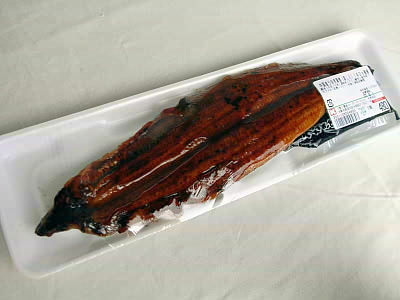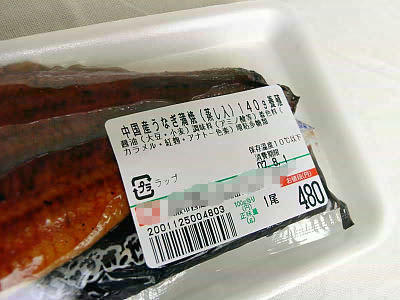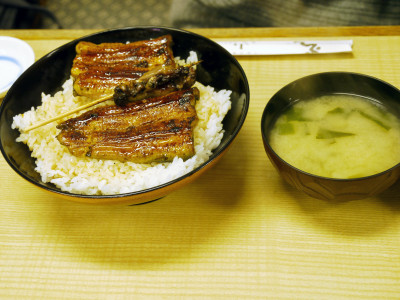Today's Midsummer Day of the Ox (Part 1): Is that eel really domestic?

Due to various recent reports on eel of Chinese origin and the various events related to "food safety"Do you really believe the display?The tide of spreading has spread, so whichever manufacturers should be seriously dealing with ... ","Is the eel really domestic?So I actually found a mysterious eel in the neighborhood's supermarket that I do not really know about where they originate from China and Kagoshima, and so I bought the three kinds and tried to compare them eating.
So, the result of the shock that you do not expect is from below.
First of all, I sold only one animal from China. Or there was only one selling area. What kind of treatment. Where did the Chinese eel, which had been massive until last week, disappear?

The price is 480 yen how. Although it exceeds the level of saying a bargain, the courage is necessary to buy it.

So these two are probably domestic. Let's show the evidence that why 'Maybe' is.

First of all, it says "Kagoshima". 690 yen.

And the other is Kore, "KagoshimaProductionIt is written. 798 yen ... ... that?

, Not "Kagoshima" but "KagoshimaProductionFor those who wrote "such a sticker is also pasted. "Produced in Kagoshima Prefecture", the manufacturer is also specified.

The appearance seems to be almost the same for both eels .... The weights are almost the same, the expiration date is the same, but the price is different ... What does that mean ...?
I have not bought even more, but there was an eel called "●● processing" (a certain prefecture name entered in ●●). The place name display of the processing factory is good, but where is the place of origin ...?
The reason why such a thing happens is that there was such a thing in the past.
Common Q & A on processed food
"Country of origin" refers to "the country in which the act causing a substantial change in the content of the product was made" as prescribed in the "illegitimate label on the country of origin of goods" based on the premium labeling law I will.
For that reason, it seems that the malicious act of processing Chinese eel in the country, displaying only the name of the processed place, called "domestic production" was done in the past. However, because the law was revised (JAS Law) it was necessary to display the country of origin properly ... ....
By the way, in 2003 the Ministry of Agriculture, Forestry and Fisheries conducted such investigation.
Outline of results of tracking confirmation survey concerning indication of raw material origin of eel processed goods
When I read this, I bought a grilled meat of eel of "domestic" display, and it was supposed that 98.1% was correct as a result of the DNA survey and as for the rest, "misdisplay of raw material origin", "missing of raw material origin" It seems that it was out due to "lack of raw material name" and "lack of preservation method". However, this DNA survey is actually a pitfall.
At the Agriculture, Forestry and Fisheries Consumption Technology Center, we purchased 80 items (80 vendors) with indication that the eel of the used ingredients is "domestic", and we performed DNA analysis to confirm the variety , All products were "Japonica species (Japanese eel)".
Major eels consumed domestically include Japonica species (Japanese eel) and Anguilla species (Europe eel), and Japonica species are cultured enterprises in Japan, China and Taiwan.
On the other hand, Anguilla species is cultured in the enterprise in China, but in Japan it is only experimental cultivation.
From this, it is clear that as a result of DNA analysis of eel, if it is confirmed that it is an Anguilla species, since the raw material is highly likely to be imported, it is proved to be "domestic eel" for the indication of the origin of origin In that case, doubts will arise in the display content.
If you read the quoted section carefully, you will understand that overseas as well cultivating "Japonica species" which is "domestic eel" .... That is why even if you conduct a DNA survey, you do not understand. I actually report on eel farming in China on the following page.
Eel crab meat situation in China.html
At a fish pond near Fuzhou city.
This is one of Japonica breeding ponds near Fuzhou city.
What is being produced here is mainly the same Japonica species that the Japanese eat from long ago, using this as a raw material to produce long grill, skewers and white gray, exporting almost 100% to Japan There.
As you can see, I do not understand anything with DNA survey. However, for products manufactured and processed in China it is properly labeled "made in China" .... That's why. I imported Japonica species that I got in China and made it to grilled eels at some processing factory in the country, so I do not know exactly where DNA survey is. So it is a misunderstanding whether the amount of eels imported from China to Japan is really decreasing ....
Perhaps the actual state of the self-proclaimed "domestic eel" is that it may just be processing the eel cultivated in China in Japan. So it's pretty bad if there is no "country of origin" on the label. "Common Q & A on processed foodAccording to "Q 9" of "" In Japan, the product which carried out "Act bringing substantial change on the content of the product" in Japan, exactly "eel grilled chicken" matches that, but in that case the country of origin is displayed It is not necessary at all, instead it is necessary to display "eel (domestic)" as "raw material name".
An eel of 690 yen denoted as "Kagoshima", an eel of 798 yen denoted as "Produced in Kagoshima" ... How is it ...?
Maybe you'll know if you eat ... ... so I tried it actually.
· Continued
Today is the Midsummer Day of the Ox (second part): "Made in China" vs "Kagoshima" vs "Kagoshima"
Related Posts:
in Tasting, Posted by darkhorse







